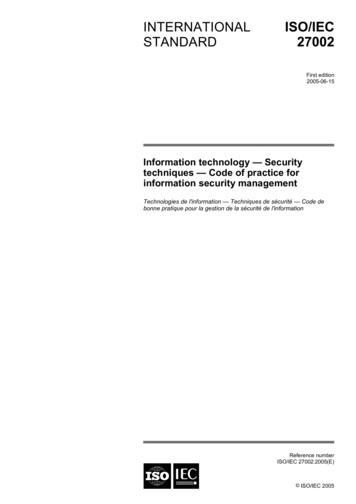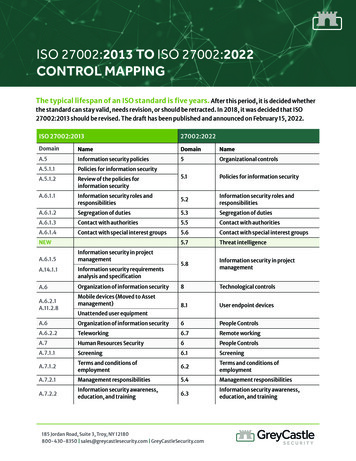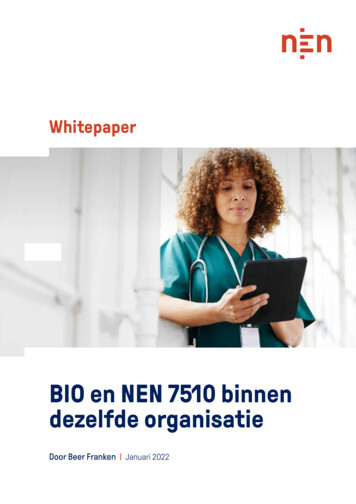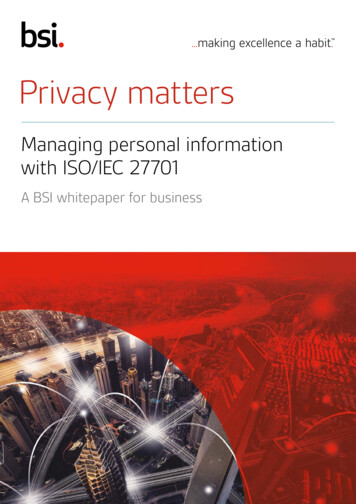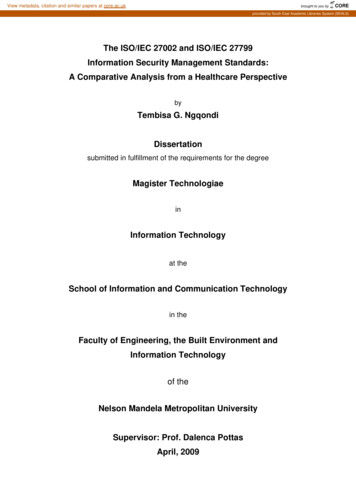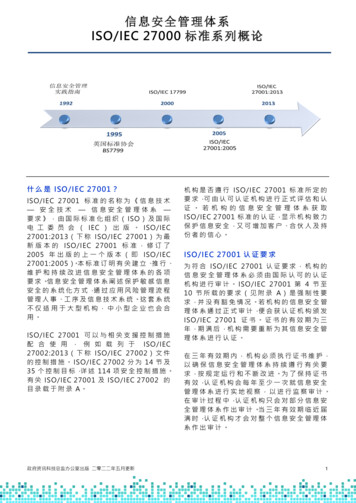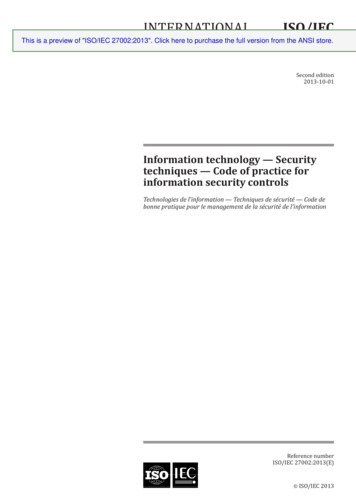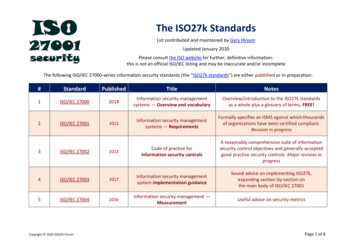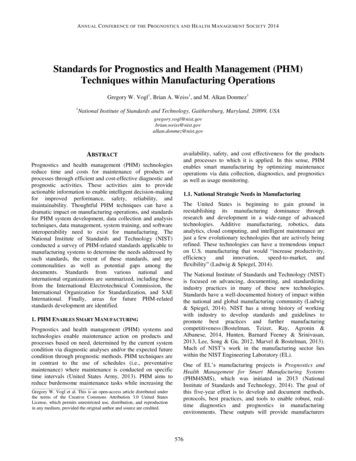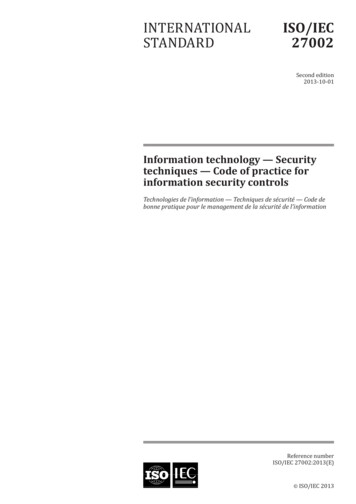
Transcription
INTERNATIONALSTANDARDISO/IEC27002Second edition2013-10-01Information technology — Securitytechniques — Code of practice forinformation security controlsTechnologies de l’information — Techniques de sécurité — Code debonne pratique pour le management de la sécurité de l’informationReference numberISO/IEC 27002:2013(E) ISO/IEC 2013
ISO/IEC 27002:2013(E) COPYRIGHT PROTECTED DOCUMENT ISO/IEC 2013All rights reserved. Unless otherwise specified, no part of this publication may be reproduced or utilized otherwise in any formor by any means, electronic or mechanical, including photocopying, or posting on the internet or an intranet, without priorwritten permission. Permission can be requested from either ISO at the address below or ISO’s member body in the country ofthe requester.ISO copyright officeCase postale 56 CH-1211 Geneva 20Tel. 41 22 749 01 11Fax 41 22 749 09 47E-mail copyright@iso.orgWeb www.iso.orgPublished in Switzerlandii ISO/IEC 2013 – All rights reserved
ISO/IEC 27002:2013(E) Contents PageForeword.v0123456789101112131415Introduction. viScope. 1Normative references. 1Terms and definitions. 1Structure of this standard. 14.1Clauses. 1Control categories. 14.2Information security policies. 25.1Management direction for information security. 2Organization of information security. 46.1Internal organization. 46.2Mobile devices and teleworking. 6Human resource security. 9Prior to employment. 97.17.2During employment. 10Termination and change of employment. 137.3Asset management.138.1Responsibility for assets. 13Information classification. 158.28.3Media handling. 17Access control.199.1Business requirements of access control. 19User access management. 219.29.3User responsibilities. 24System and application access control. 259.4Cryptography.2810.1 Cryptographic controls. 28Physical and environmental security.3011.1 Secure areas. 3011.2 Equipment. 33Operations security.3812.1 Operational procedures and responsibilities. 3812.2 Protection from malware. 4112.3 Backup. 4212.4 Logging and monitoring. 4312.5 Control of operational software. 4512.6 Technical vulnerability management. 4612.7 Information systems audit considerations. 48Communications security.4913.1 Network security management. 4913.2 Information transfer. 50System acquisition, development and maintenance.5414.1 Security requirements of information systems. 5414.2 Security in development and support processes. 5714.3 Test data. 62Supplier relationships.6215.1 Information security in supplier relationships. 62 ISO/IEC 2013 – All rights reserved iii
ISO/IEC 27002:2013(E) 16171815.2Supplier service delivery management. 66Information security incident management.6716.1 Management of information security incidents and improvements. 67Information security aspects of business continuity management.7117.1 Information security continuity. 7117.2 Redundancies. 73Compliance.7418.1 Compliance with legal and contractual requirements. 7418.2 Information security reviews. 77Bibliography. 79iv ISO/IEC 2013 – All rights reserved
ISO/IEC 27002:2013(E) ForewordISO (the International Organization for Standardization) and IEC (the International ElectrotechnicalCommission) form the specialized system for worldwide standardization. National bodies that aremembers of ISO or IEC participate in the development of International Standards through technicalcommittees established by the respective organization to deal with particular fields of technicalactivity. ISO and IEC technical committees collaborate in fields of mutual interest. Other internationalorganizations, governmental and non-governmental, in liaison with ISO and IEC, also take part in thework. In the field of information technology, ISO and IEC have established a joint technical committee,ISO/IEC JTC 1.International Standards are drafted in accordance with the rules given in the ISO/IEC Directives, Part 2.ISO/IEC 27002 was prepared by Joint Technical Committee ISO/IEC JTC 1, Information technology,Subcommittee SC 27, IT Security techniques.Attention is drawn to the possibility that some of the elements of this document may be the subject ofpatent rights. ISO shall not be held responsible for identifying any or all such patent rights.This second edition cancels and replaces the first edition (ISO/IEC 27002:2005), which has beentechnically and structurally revised. ISO/IEC 2013 – All rights reserved v
ISO/IEC 27002:2013(E) 0Introduction0.1Background and contextThis International Standard is designed for organizations to use as a reference for selecting controlswithin the process of implementing an Information Security Management System (ISMS) based onISO/IEC 27001[10] or as a guidance document for organizations implementing commonly acceptedinformation security controls. This standard is also intended for use in developing industry- andorganization-specific information security management guidelines, taking into consideration theirspecific information security risk environment(s).Organizations of all types and sizes (including public and private sector, commercial and non-profit)collect, process, store and transmit information in many forms including electronic, physical and verbal(e.g. conversations and presentations).The value of information goes beyond the written words, numbers and images: knowledge, concepts, ideasand brands are examples of intangible forms of information. In an interconnected world, information andrelated processes, systems, networks and personnel involved in their operation, handling and protectionare assets that, like other important business assets, are valuable to an organization’s business andconsequently deserve or require protection against various hazards.Assets are subject to both deliberate and accidental threats while the related processes, systems,networks and people have inherent vulnerabilities. Changes to business processes and systems orother external changes (such as new laws and regulations) may create new information security risks.Therefore, given the multitude of ways in which threats could take advantage of vulnerabilities to harmthe organization, information security risks are always present. Effective information security reducesthese risks by protecting the organization against threats and vulnerabilities, and then reduces impactsto its assets.Information security is achieved by implementing a suitable set of controls, including policies, processes,procedures, organizational structures and software and hardware functions. These controls need tobe established, implemented, monitored, reviewed and improved, where necessary, to ensure that thespecific security and business objectives of the organization are met. An ISMS such as that specified inISO/IEC 27001[10] takes a holistic, coordinated view of the organization’s information security risks inorder to implement a comprehensive suite of information security controls under the overall frameworkof a coherent management system.Many information systems have not been designed to be secure in the sense of ISO/IEC 27001[10] and thisstandard. The security that can be achieved through technical means is limited and should be supportedby appropriate management and procedures. Identifying which controls should be in place requirescareful planning and attention to detail. A successful ISMS requires support by all employees in theorganization. It can also require participation from shareholders, suppliers or other external parties.Specialist advice from external parties can also be needed.In a more general sense, effective information security also assures management and other stakeholdersthat the organization’s assets are reasonably safe and protected against harm, thereby acting as abusiness enabler.0.2Information security requirementsIt is essential that an organization identifies its security requirements. There are three main sources ofsecurity requirements:a)the assessment of risks to the organization, taking into account the organization’s overall businessstrategy and objectives. Through a risk assessment, threats to assets are identified, vulnerability toand likelihood of occurrence is evaluated and potential impact is estimated;b) the legal, statutory, regulatory and contractual requirements that an organization, its tradingpartners, contractors and service providers have to satisfy, and their socio-cultural environment;vi ISO/IEC 2013 – All rights reserved
ISO/IEC 27002:2013(E) c)the set of principles, objectives and business requirements for information handling, processing,storing, communicating and archiving that an organization has developed to support its operations.Resources employed in implementing controls need to be balanced against the business harm likelyto result from security issues in the absence of those controls. The results of a risk assessment willhelp guide and determine the appropriate management action and priorities for managing informationsecurity risks and for implementing controls selected to protect against these risks.ISO/IEC 27005[11] provides information security risk management guidance, including advice on riskassessment, risk treatment, risk acceptance, risk communication, risk monitoring and risk review.0.3Selecting controlsControls can be selected from this standard or from other control sets, or new controls can be designedto meet specific needs as appropriate.The selection of controls is dependent upon organizational decisions based on the criteria for riskacceptance, risk treatment options and the general risk management approach applied to the organization,and should also be subject to all relevant national and international legislation and regulations. Controlselection also depends on the manner in which controls interact to provide defence in depth.Some of the controls in this standard can be considered as guiding principles for information securitymanagement and applicable for most organizations. The controls are explained in more detail belowalong with implementation guidance. More information about selecting controls and other risk treatmentoptions can be found in ISO/IEC 27005.[11]0.4Developing your own guidelinesThis International Standard may be regarded as a starting point for developing organization-specificguidelines. Not all of the controls and guidance in this code of practice may be applicable. Furthermore,additional controls and guidelines not included in this standard may be required. When documents aredeveloped containing additional guidelines or controls, it may be useful to include cross-references to clausesin this standard where applicable to facilitate compliance checking by auditors and business partners.0.5Lifecycle considerationsInformation has a natural lifecycle, from creation and origination through storage, processing, use andtransmission to its eventual destruction or decay. The value of, and risks to, assets may vary during theirlifetime (e.g. unauthorized disclosure or theft of a company’s financial accounts is far less significant afterthey have been formally published) but information security remains important to some extent at all stages.Information systems have lifecycles within which they are conceived, specified, designed, developed,tested, implemented, used, maintained and eventually retired from service and disposed of. Informationsecurity should be taken into account at every stage. New system developments and changes to existingsystems present opportunities for organizations to update and improve security controls, taking actualincidents and current and projected information security risks into account.0.6Related standardsWhile this standard offers guidance on a broad range of information security controls that arecommonly applied in many different organizations, the remaining standards in the ISO/IEC 27000family provide complementary advice or requirements on other aspects of the overall process ofmanaging information security.Refer to ISO/IEC 27000 for a general introduction to both ISMSs and the family of standards. ISO/IEC 27000provides a glossary, formally defining most of the terms used throughout the ISO/IEC 27000 family ofstandards, and describes the scope and objectives for each member of the family. ISO/IEC 2013 – All rights reserved vii
INTERNATIONAL STANDARD ISO/IEC 27002:2013(E)Information technology — Security techniques — Code ofpractice for information security controls1 ScopeThis International Standard gives guidelines for organizational information security standards andinformation security management practices including the selection, implementation and managementof controls taking into consideration the organization’s information security risk environment(s).This International Standard is designed to be used by organizations that intend to:a)select controls within the process of implementing an Information Security Management Systembased on ISO/IEC 27001;[10]c)develop their own information security management guidelines.b) implement commonly accepted information security controls;2 Normative referencesThe following documents, in whole or in part, are normatively referenced in this document and areindispensable for its application. For dated references, only the edition cited applies. For undatedreferences, the latest edition of the referenced document (including any amendments) applies.ISO/IEC 27000, Information technology — Security techniques — Information security managementsystems — Overview and vocabulary3 Terms and definitionsFor the purposes of this document, the terms and definitions given in ISO/IEC 27000 apply.4 Structure of this standardThis standard contains 14 security control clauses collectively containing a total of 35 main securitycategories and 114 controls.4.1 ClausesEach clause defining security controls contains one or more main security categories.The order of the clauses in this standard does not imply their importance. Depending on the circumstances,security controls from any or all clauses could be important, therefore each organization applying thisstandard should identify applicable controls, how important these are and their application to individualbusiness processes. Furthermore, lists in this standard are not in priority order.4.2 Control categoriesEach main security control category contains:a)a control objective stating what is to be achieved;b) one or more controls that can be applied to achieve the control objective. ISO/IEC 2013 – All rights reserved 1
ISO/IEC 27002:2013(E) Control descriptions are structured as follows:ControlDefines the specific control statement, to satisfy the control objective.Implementation guidanceProvides more detailed information to support the implementation of the control and meeting thecontrol objective. The guidance may not be entirely suitable or sufficient in all situations and may notfulfil the organization’s specific control requirements. .Other informationProvides further information that may need to be considered, for example legal considerations andreferences to other standards. If there is no other information to be provided this part is not shown.5 Information security policies5.1 Management direction for information securityObjective: To provide management direction and support for information security in accordance withbusiness requirements and relevant laws and regulations.5.1.1Policies for information securityControlA set of policies for information security should be defined, approved by management, published andcommunicated to employees and relevant external parties.Implementation guidanceAt the highest level, organizations should define an “information security policy” which is approved bymanagement and which sets out the organization’s approach to managing its information security objectives.Information security policies should address requirements created by:a)business strategy;c)the current and projected information security threat environment.a)definition of information security, objectives and principles to guide all activities relating toinformation security;c)processes for handling deviations and exceptions.b) regulations, legislation and contracts;The information security policy should contain statements concerning:b) assignment of general and specific responsibilities for information security management todefined roles;At a lower level, the information security policy should be supported by topic-specific policies, whichfurther mandate the implementation of information security controls and are typically structured toaddress the needs of certain target groups within an organization or to cover certain topics.Examples of such policy topics include:a)2 access control (see Clause 9); ISO/IEC 2013 – All rights reserved
ISO/IEC 27002:2013(E) b) information classification (and handling) (see 8.2);c)physical and environmental security (see Clause 11);d) end user oriented topics such as:1) acceptable use of assets (see 8.1.3);2) clear desk and clear screen (see 11.2.9);3) information transfer (see 13.2.1);4) mobile devices and teleworking (see 6.2);e)f)5) restrictions on software installations and use (see 12.6.2);backup (see 12.3);information transfer (see 13.2);g) protection from malware (see 12.2);h) management of technical vulnerabilities (see 12.6.1);i)j)cryptographic controls (see Clause 10);communications security (see Clause 13);k) privacy and protection of personally identifiable information (see 18.1.4);l)supplier relationships (see Clause 15).These policies should be communicated to employees and relevant external parties in a form that isrelevant, accessible and understandable to the intended reader, e.g. in the context of an “informationsecurity awareness, education and training programme” (see 7.2.2).Other informationThe need for internal policies for information security varies across organizations. Internal policiesare especially useful in larger and more complex organizations where those defining and approvingthe expected levels of control are segregated from those implementing the controls or in situationswhere a policy applies to many different people or functions in the organization. Policies for informationsecurity can be issued in a single “information security policy” document or as a set of individual butrelated documents.If any of the information security policies are distributed outside the organization, care should be takennot to disclose confidential information.Some organizations use other terms for these policy documents, such as “Standards”, “Directives” or “Rules”.5.1.2Review of the policies for information securityControlThe policies for information security should be reviewed at planned intervals or if significant changesoccur to ensure their continuing suitability, adequacy and effectiveness.Implementation guidanceEach policy should have an owner who has approved management responsibility for the development,review and evaluation of the policies. The review should include assessing opportunities for improvementof the organization’s policies and approach to managing information security in response to changes tothe organizational environment, business circumstances, legal conditions or technical environment. ISO/IEC 2013 – All rights reserved 3
ISO/IEC 27002:2013(E) The review of policies for information security should take the results of management reviews into account.Management approval for a revised policy should be obtained.6 Organization of information security6.1 Internal organizationObjective: To establish a management framework to initiate and control the implementation andoperation of information security within the organization.6.1.1Information security roles and responsibilitiesControlAll information security responsibilities should be defined and allocated.Implementation guidanceAllocation of information security responsibilities should be done in accordance with the informationsecurity policies (see 5.1.1). Responsibilities for the protection of individual assets and for carrying outspecific information security processes should be identified. Responsibilities for information securityrisk management activities and in particular for acceptance of residual risks should be defined. Theseresponsibilities should be supplemented, where necessary, with more detailed guidance for specificsites and information processing facilities. Local responsibilities for the protection of assets and forcarrying out specific security processes should be defined.Individuals with allocated information security responsibilities may delegate security tasks to others.Nevertheless they remain accountable and should determine that any delegated tasks have beencorrectly performed.Areas for which individuals are responsible should be stated. In particular the following should take place:a)the assets and information security processes should be identified and defined;c)authorization levels should be defined
work. In the field of information technology, ISO and IEC have established a joint technical committee, ISO/IEC JTC 1. International Standards are drafted in accordance with the rules given in the ISO/IEC Directives, Part 2. ISO/IEC 27002 was prepared by Joint Technical Committee ISO/IEC JTC 1, Information technology, Subcommittee SC 27, IT .
